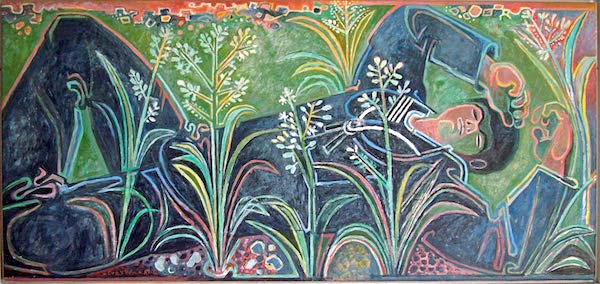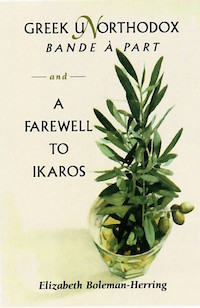In The Ear of The Beholder: Stories
“I like the monologue even more than the duet, when it is good. It’s like watching a man write a book expressly for you: he writes it, reads it aloud, acts it, revises it, savors it, enjoys it, enjoys your enjoyment of it, and then tears it up and throws it to the winds. It’s a sublime performance, because while he’s going through with it you are God for him—unless you happen to be an insensitive and impatient dolt. But in that case the kind of monologue I refer to never happens.”—Henry Miller
By Way of Being
By Elizabeth Boleman-Herring

“The best stories I have heard were pointless, the best books those whose plot I can never remember, the best individuals those whom I never get anywhere with. Though it has been practiced on me time and again I never cease to marvel how it happens that with certain individuals whom I know, within a few minutes after greeting them we are embarked on an endless voyage comparable in feeling and trajectory only to the deep middle dream which the practiced dreamer slips into like a bone slips into its socket.”―Henry Miller, “The Colossus of Maroussi”
PETIT TRIANON Florida—(Weekly Hubris)—February 2017—Generations of my mother’s and father’s people flourished upon the soils of the deep American South; nourished as much by the region’s vaunted oral tradition as by field peas and snaps, collards and ham hocks, and cornbread baked in iron skillets.
If I were writing a Wikipedia entry for my clan’s foremost oral bards, it would begin, “Boleman Storytellers (fl. 1920-1960),” for they did gather and flourish during a discrete 40-year-long interval in Upstate South Carolina.
Beginning in childhood, as a member of my family storytellers’ audience, I was a Southerner-Always-at-Least-Once-Removed. (For those of you “from elsewhere,” the connection known as Once-, Twice-, and etc.-Removed parses thus: there is a relational difference of one generation. For example, your mother’s first cousin is your first cousin, once removed. Twice removed means that there is a two-generation difference. You are two generations younger than a first cousin of your grandmother, so you and your grandmother’s first cousin are first cousins, twice removed.)
If I digress, I assure you that digression is one hallmark of Southern stories as told on sweltering summer evenings, rocking on someone’s side porch, or while gathered, in multiple generations, around a family dining table.
Southerners digress, and digress, and digress again, but eventually return to the thread of our tales. The frame narrative is as old, at least, as the Westcar Papyrus (Egypt, 18th-16th century BC), but alive and well 3.7 millennia later in such places as Seneca, South Carolina.
Transplanted from the South to Southern California in infancy, I was but a fleeting visitor to the South Carolinian and Floridian and Georgian kitchens of my extended family during the 1950s but, as we all sat in the gloaming at Aunt Willie Sue’s in Seneca, drinking sweet tea in the deepening darkness, I first heard the family stories, and especially the long account, elaborated upon by three generations of Bolemans and Mahaffeys, of the night Jeff Webb and his young friends set off the dynamite in rural Townville, population at the time roughly 100.
I must admit here and now that I cannot tell this story. Too much of it is gone with its tellers, and I was not touched with the oral gift. Note well, Gentle Reader: I cannot tell you any of the tall, incredible tales of my life, wherever I heard them, for the simple reason that story-telling is a rare and ephemeral gift bestowed on very few of us. Almost always, great told stories die with those who tell them, which is as it must be.
We may have photographs of the great Nijinsky, and scraps of movie footage but, in Nijinsky’s case, and in the case of our great storytellers, the dance dies with the dancer; the story ends with the last breath of its teller.
Only two of my living family members now recall the story of the dynamite: my first cousins Larry Mahaffey, now in his mid-70s, and his older brother, Clay Randolph, of Spartanburg SC. I’ve not seen Larry in years, but he is the only Boleman alive who was touched with the knack of oral story-telling, and just to think of him, and to recall his face as he launched into a tale—the quiet glee that anticipated the story’s main elements—well, remembering Larry telling a yarn is almost as good as hearing it once again.
I’ve just picked up the phone and called him. Because Larry remained in the South, as I did not, his inflections, his accent, the emphases he creates in sentences, are of another time and place, Upstate South Carolina in the 1940s.
He recalls certain details of the story of the dynamite I never knew, but much of the substance is gone, for both of us.

In 1961, after making a stop in Seneca, at my Aunt Willie Sue’s, her long-since-subdued-by-age-and-social-status husband Jeff Webb only recently dead, my parents and I departed for three years in Greece, leaving behind one culture with a rich tradition of oral storytelling for another.
My mother had “read ahead,” as was her custom, and came to Greece already knowing the stories of Henry Miller and Lawrence Durrell and, twice-removed, the stories of the “Colossus” of Miller’s book. Miller’s The Colossus of Maroussi, published in 1941, centers upon the Athenian (Maroussi is a suburb of the Greek capital) poet and raconteur George Katsimbalis (fl. 1930s-40s), a storyteller who left his mark on everyone within earshot but especially writers, both Greek and English, of his wartime generation.
From Katsimbalis, I found myself once again only once-removed, as I heard the echoes of some of his famous (long-famous) tales from the lips of my own literary mentor, Patrick Leigh Fermor (as well as from Edmund Keeley and Kevin Andrews).
I can name-drop with the best of the still-living Philhellenic scribes, as I sought out in person my literary lions, read their canonical books, and then published lesser works by those still living, writing, and holding forth at Athenian cafés and tavernas in the 1980s.
Leigh Fermor’s prose engendered such passion in me that I, and my then- (now-late-) husband, photographer Æmilios Moriannides made a pilgrimage of sorts to The Mani, and bearded Leigh Fermor and his wife Joan in their Kardamyli den, braving a gauntlet mounted by their knife-wielding chatelaine (she was sharpening a huge blade on a stone wheel just outside the entrance to their house) in order first to speak to the author, and then be invited back for a meal.
I recall that, at our first meeting, Leigh Fermor was, quite properly, more attentive to Æmilios than to me, for my husband had, for a philhellene, a much more interesting pedigree. Born to a Cairene-Greek father and Cephalonian mother, whose arranged marriage was celebrated in then-Rhodesia, Æmilios was the greatest storyteller I have ever known. Paddy engaged him in both English, Æmilios’s first language, and Greek, but my husband was too shy in the presence of the famous writer to launch into one of the oral set pieces so well known to his Athenian parea (circle of intimates).
And it is a parea that is the natural complement to the storyteller, whether South Carolinian or Greek. Like a chorus hanging on the protagonist’s every word, the parea, whether composed of family members, friends or, as in Æmilios’s case, a close-knit group with whom my husband had weathered childhood, high school, the army, and professional life in a small city of walkers and talkers, the parea is a story-teller’s enduring and loyal audience.
Henry Miller quotes his Katsimbalis: “To tell a good story . . . you have to have a good listener. I can’t tell a story to an automaton who writes short-hand. Besides, the best stories are those which you don’t want to preserve. If you have any arrière-pensée the story is ruined. It must be a sheer gift . . . you must throw it to the dogs . . . . I’m not a writer . . . I’m an extemporaneous fellow. I like to hear myself talk. I talk too much—it’s a vice . . . . What good would it be to be a writer, a Greek writer? Nobody reads Greek!”
Of course, Katsimbalis was dead wrong about some things: my mother had already read Kazantzakis, that most Greek of Greek writers, in the 1960s (and I would know Kimon Friar, read his translations of Kazantzakis in the 70s and 80s, and publish some of his work in the 90s).
But Æmilios’s stories had to be heard, and could never be written. Perhaps we who heard them often failed in not transcribing them, but all we ever had to do, if there were time enough and wine, was say, “Æm, tell the story of Pandora, Andonis, and the rat” or, “Tell the story of Zahid, Æmil,” and he would begin . . . and go on, and on, into the night.
Æmilios’s performances, like Larry Mahaffey’s (and Nijinsky’s), were “monologues.”
As Henry Miller writes, in The Colossus of Maroussi: “I like the monologue even more than the duet, when it is good. It’s like watching a man write a book expressly for you: he writes it, reads it aloud, acts it, revises it, savors it, enjoys it, enjoys your enjoyment of it, and then tears it up and throws it to the winds. It’s a sublime performance, because while he’s going through with it you are God for him—unless you happen to be an insensitive and impatient dolt. But in that case the kind of monologue I refer to never happens.”
And such was Æmilios when in full throat. Each of his stories could take, properly told, hours to relate, and all we in his audience could do was wait, helplessly laughing, for each familiar marker on the path to resolution, egging him on. We had all, in English or Greek or both, heard these stories many, many but never enough times. There were no surprises in the narratives, unless someone was new to the parea but, if there were first-time listeners, the pleasure of the rest of us was even greater.
I can no more tell Æmilios’s stories than can the very, very few others still alive who remember them, and him. I can only tell you that, in the case of certain story-tellers (Katsimbalis, Leigh Fermor, Æmilios) to hear them was sublime. The stories were in their telling, and that experience could not be captured, nor preserved, in the simple receptacle that is writing.
Nijinksy was his dance. And even those with an arrière-pensée could not preserve his gift.
Miller, again: “When the Greek leaves a place he leaves a hole.”
As I remember Patrick Leigh Fermor, declaiming, Æmilios speaking, Kevin Andrews reciting, I remember the men as irreplaceable integers of form and voice and intellect, quite different from what any of them was in writing; nailed to a printed page. They leap up in my memory still . . . like sturdy if ephemeral flames, like living if dying trees, like dancers caught in mid-grand-jeté.
In memory, they call to mind the words of William Butler Yeats in “About School Children”: “O body swayed to music, O brightening glance,/How can we know the dancer from the dance?”


“Jeff Webb & The Dynamite”
Jeff Newton Webb, a very young Upstate South Carolinian who earned his MD at Emory in Atlanta in the early 1900s, and then returned to his native South Carolina to practice as a country doctor, was, I believe, simply bored by life in the rural South. After Atlanta’s comparably bright lights, Townville, population 100, where he would marry the prettiest flapper in town (and deliver her baby sister, my mother) must have seemed in need of some livening up.
So, Webb and his Oconee County cohorts, a small group of young rakes who may or may not have included Larry and Randy’s father, Clay Randolph Mahaffey, Sr. (who later married my mother’s sister, Inez), decided to pull a prank (Larry’s word for it) and make some serious noise.
In the dead of a cold and silent spring night, when no one was about, and having warned only one soul in advance—an elderly and very sickly man who might have died from fright had he not been in on the caper—Webb and friends set off a prodigious amount of dynamite which they had first suspended high in the branches of a tree. (Up in a tree “to make more of a racket,” adds Larry.)
Our Great Uncle Bob, a wealthy mule-trader, living at the time with our maternal grandparents in a huge Victorian pile nearby, awoke in a panic and, famously, tore along the long central hall to go down on his knees before his long-suffering wife, our Great Aunt, declaiming, “Johnnie, Johnnie! If ever I’ve done anything to offend you, Good Lord forgive me, for it’s Judgment Day!”
Throughout the county, those awakened by the blast thought, variously, that the hydroelectric works at Portman Dam had blown up or, like Great Uncle Bob, that Judgment Day was upon them.
And, though this story was told and elaborated upon in my family for over half a century after the event, none of the men involved ever admitted taking part in the affair, and went to their graves without confessing.
“Pandora, Andonis & The Rat”
Pandora, Æmilios’s first wife, calls him at work in hysterics to tell him there is an enormous, fearless rat in their second-floor Athenian apartment, and the young husband, though deathly afraid of rodents, rushes home, only to find his wily antagonist nowhere to be seen.
Forswearing sleep till the rat is dead, Pandora takes to their bed, leaving Æmilios to sit up and keep watch. He does so, and the rat appears, and disappears, several times over the course of Night One, Æmilios exiting Stage Left or Right in terror.
The morning following (Day Two), Æmil enlists the aid of his childhood friend, Andonis, who comes over to the flat bearing prodigious quantities of rat poison. The pair of men bait the living room and retire to the kitchen, a bit like Oliver and Hardy: the next morning (Day Three), they discover the rat has gobbled up the bait, but is showing no ill effects and, instead, seems to taunt them in their helplessness before waddling fatly off through a hole in the wall.
Next, Æmil and Andonis try salted bait and water, reasoning that the rat’s intestines will not withstand these three substances in any quantity. They also surround the bait trays with traps and hazards (requiring feats of Hellenic engineering intended to prevent the rat from getting at his tormenters), all of which ploys fail, the rat visibly stouter but no less menacing for all their pains. Meanwhile, three nights sleepless, Pandora rails in the background like a tragic Greek heroine, and the Moriannides marriage teeters on the brink.
Finally (Day Four), Æmil vows that not another night shall pass for the rat. Sleep deprived, frenzied by Pandora’s imprecations, and overcoming at last his terrific fear of vermin, he breaks out his ancient army bayonet and sits up all night in the living room, awaiting the rat’s entrance: with a bloodcurdling yell, at dawn on Day Five, he skewers the beast: it is over.
“The Story of Zahid”
The Story of Zahid, the diminutive and silent Pakistani immigrant who rented a tiny apartment in Æmilios and his cousin’s Athenian apartment building, is the shortest tale of all, in its bare bones, but always took hours to relate.
Zahid, to Æmilios, was a kind of cipher. He spoke no Greek and very little English, and seemed to have no earthly possessions besides a single change of nondescript clothes and a pair of rubber sandals, summer and winter.
Æmil, who acted as the building’s Super, repeatedly had to rescue bits of communal building furniture—a chair from the laundry room, a broken table from the roof, a fellow renter’s welcome mat—from Zahid’s all-but-empty flat as well as attempt to explain to the man the rules and regulations applying to all renters, including (but not limited to) abjuring Zahid against pilfering electricity by running cords out his apartment window to sockets in the hall.
One day, a year into their relationship, if it could be called that, in the hall outside Æmilios’s flat, his computer having, yet again, crashed, consigning untold megabytes of data to the ether, Æmilios was complaining, absently, to no one in particular, when Zahid looked up, said loudly, “Computer!?” and, brushing by Æmilios and into his sitting room, sat down at the computer and, with a flourish, began to operate the keyboard with great mastery. Æmilios, spellbound, sat down beside him as Zahid recovered all the lost data and set both his hard- and soft-ware to rights.
Zahid (fl. 1980s), of Pakistan, was obviously a dark horse of the first water.
![]()
Further Reading & Listening
These readings, in no particular order, are available online, providing just a few tantalizing tastes of the Greece I knew between the 1960s and 1990s, when my particular group of storytellers was extant:
1) “Poetry in Motion: Inventing Paradise: The Greek Journey, 1937-47, By Edmund Keeley,” Bernard Knox, June 27, 1999, The Washington Post.
2) “High Life,” by Taki, March 23, 2013, The Spectator.
3) “Children of Paradise: Edmund Keeley, Inventing Paradise: The Greek Journey 1937-1947,” by Dino Siotis, Translated by Nina Gatzoulis.
4) “Going Mad for Greece: The Colossus of Maroussi, by Henry Miller, with an Introduction by Will Self and an Afterword by S. MacNiven, by Pico Iyer, “The New York Review of Books,” December 23, 2010.
5) “Paperback Writers: Henry Miller’s Grecian days: A reissue of The Colossus of Maroussi chronicles the American writer’s travels around Greece with pal Lawrence Durrell in the grim days of World War II,” by Richard Rayner, Special to the “Los Angeles Times,” July 25, 210.
6) In the Greek TV station EPT (“ERT”) archives are two short films depicting Patrick Leigh Fermor as I knew him: https://patrickleighfermor.org/2011/07/30/george-katsimbalis-documentary-part-1-by-the-acropolis-and-at-the-bar/ and https://patrickleighfermor.org/2011/08/06/george-katsimbalis-documentary-part-2-paddy-sings-about-greek-debt/
7) Miller, Henry, The Colossus of Maroussi .
8) Leigh Fermor, Patrick, Mani: Travels in The Southern Peloponnese.
9) Andrews, Kevin, The Flight of Ikaros
10) Boleman-Herring, Elizabeth, Greek Unorthodox: Bande à Part & A Farewell To Ikaros.
11) Keeley, Edmund L., A Century of Greek Poetry 1900-2000: Bilingual Edition.
![]()
About the Illustrations
To read about painter John Craxton, who created the jacket art for all of Patrick Leigh Fermor’s first editions, see: http://www.apollo-magazine.com/arcadia-outlined/ and https://patrickleighfermor.org/tag/john-craxton/page/2/.
![]()
To order Elizabeth Boleman-Herring’s memoir and/or her erotic novel, click on the book covers below:




4 Comments
Anita Sullivan
What a totally satisfying piece of writing. It made me long to hear a good storyteller, preferably a “natural,” not one who does it for a living. And thanks too for the marvelous John Craxton paintings, I wish my Patrick Leigh Fermor paperbacks included them, but they do not. As always, I come away from your WH posts enriched by language and images and ideas, thank you!
Elizabeth Boleman-Herring
Bless you and keep you, Anita. As your own “first reader” on Weekly Hubris . . . the editor’s version of prima nocta ;-) . . . I so enjoy your essays, as well. Greece in the 1980s, when PLF, Craxton, the Keeleys, Friar, et al were still rubbing shoulders and sitting at one another’s elbows was such a time of stories! At the end of the (and my) day, however, it’s Aemilios’s humbler tales I miss most.
Christina Askounis
What a wonderful piece! I loved learning more about you and reading these stories. And I marvel at the similarity of some of the threads that run through your life and mine (far quieter and less illustrious). I too grew up listening to Southerners tell stories–in my case, on the screened porch of the “home place”, on the south Georgia farm where my mother grew up (and was desperate to escape). She married my Greek-American father during WWII when he was a young pilot stationed near Albany. He stayed in the Air Force after the war as a test pilot and we moved frequently, with the farm and my father’s hometown of Chicago the two poles of my existence, though we were rarely at either one for long. Still, both places wove spells over me, utterly distinctive from each other, but both having to do with language, the love of it, of the torrents of Greek spoken by all my father’s relatives, the syllables clicking like dice or chanted, rising like the smoke of incense in the Church of St. Nicholas on the South Side, where I was christened, and then the soft, almost musical speech of my mother’s family, who unlike the Greeks, never raised their voices but like them, possessed a mysterious vocabulary of their own. And in both places there were stories: my father’s, hyperbolic as those of Miller’s Colossus but completely convincing by virtue of his air of authority and his startling gift for recalling detail with crystalline accuracy, and those of his younger sister, my Thea Coula, who enthralled me with tales of how YiaYia had undone the curse of the “evil eye.” In Georgia, my aunts and grandmother–my Scheherazades–would sit in rocking chairs on the porch shelling “a mess” of butter beans and entertaining themselves with gossip and family history, stories handed down from before the Civil War, while I made myself as inconspicuous as possible so I could eavesdrop undetected. Every now and then they would lower their voices, and I knew that was when I needed to listen especially closely. How rich it all was, how impossible to recapture even a bit of that quicksilver–as mesmerizing as fireflies glimmering in the darkness, and as ephemeral. But you have evoked it all for me here. Thank you!
Elizabeth Boleman-Herring
Christinamou, thank you so, so much for this response. We most assuredly do share many of the same threads in our tapestries. It is gratifying to find another for whom a mess of butter beans and a cleansing from To Mati make perfect sense. I loved the evocation of your Georgia aunts! Filia polla, Elisavet